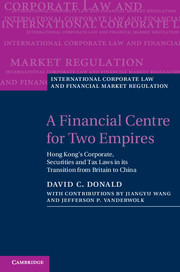 A Financial Centre for Two Empires
A Financial Centre for Two Empires the legal and policy dimensions
Published online by Cambridge University Press: 05 June 2014
Introduction: integration, competition and erosion
Hong Kong’s ambition to maintain its position as an international financial centre – or even to become a more significant one, depends overwhelmingly on the market of mainland China (hereinafter the mainland, China or the PRC). China, however, provides a mixed blessing for Hong Kong in this regard, arising out of the inevitable co-existence of integration and competition between the two regions under Chinese sovereignty.
As the hub of China trade and investment for more than a century, Hong Kong has played a significant historical and current role in the development of the Chinese economy. Hong Kong’s importance for China, at least from an economic perspective, is beyond doubt. As noted by historian Steve Tsang, by 1997, the year Hong Kong was returned to China by the United Kingdom, ‘Hong Kong had become the largest source of investments in a very wide spectrum of economic activities and the most important capital market for the PRC … It was the PRC’s key trading partner, middleman, financier and facilitator that underpinned the economic reform of Deng Xiaoping.’ In short, ‘Hong Kong’s economy did not merge into that of the PRC in 1997 but the two economies had by then become so intricately linked that the wellbeing of one had become crucial for the other’.
To save this book to your Kindle, first ensure [email protected] is added to your Approved Personal Document E-mail List under your Personal Document Settings on the Manage Your Content and Devices page of your Amazon account. Then enter the ‘name’ part of your Kindle email address below. Find out more about saving to your Kindle.
Note you can select to save to either the @free.kindle.com or @kindle.com variations. ‘@free.kindle.com’ emails are free but can only be saved to your device when it is connected to wi-fi. ‘@kindle.com’ emails can be delivered even when you are not connected to wi-fi, but note that service fees apply.
Find out more about the Kindle Personal Document Service.
To save content items to your account, please confirm that you agree to abide by our usage policies. If this is the first time you use this feature, you will be asked to authorise Cambridge Core to connect with your account. Find out more about saving content to Dropbox.
To save content items to your account, please confirm that you agree to abide by our usage policies. If this is the first time you use this feature, you will be asked to authorise Cambridge Core to connect with your account. Find out more about saving content to Google Drive.